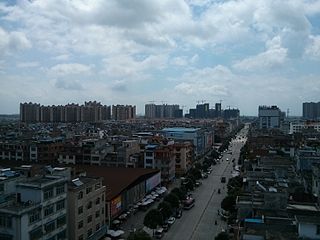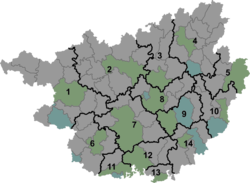
Sanjiang Dong Autonomous County is under the administration of Liuzhou, Guangxi Zhuang Autonomous Region, China. It is a region traditionally inhabited by the Dong people, bordering the prefecture-level divisions of Qiandongnan (Guizhou) to the north, Huaihua (Hunan) to the northeast and Guilin to the west.

Binyang County is under the administration of Nanning, the capital of Guangxi Zhuang Autonomous Region, China, with a permanent population of 782,255 and a hukou population of 1,051,373 as of the 2010 Census. It borders the prefecture-level cities of Laibin to the northeast and Guigang to the east. The main highways passing near the county seat are China National Highways 322 and 324. The local economy is based mostly on industry and services. The county seat is Binzhou Town, known as one of the oldest towns in Guangxi which has population over 200,000 people. People speak Binyanghua in Binyang, which is a branch of Cantonese.

Liucheng County is under the administration of Liuzhou, Guangxi Zhuang Autonomous Region, China. It covers a land area of 2,109.78 square kilometres (814.59 sq mi) and had a permanent population of 353,796 as of 2010. Located north of Liuzhou's city proper, it borders the prefecture-level city of Hechi to the west.

Yongning District is one of six districts of Nanning, the capital of Guangxi Zhuang Autonomous Region, China. The district's total area is 1295 square kilometers, and its population in 2004 was 316,000 people.

Wuming District is under the administration of Nanning, the capital of Guangxi Zhuang Autonomous Region, China. Located north of the city proper, it borders the prefecture-level city of Baise to the west.

Mashan County is under the administration of Nanning, the capital of Guangxi Zhuang Autonomous Region, China. The northernmost county-level division of Nanning City, it borders the prefecture-level cities of Hechi to the north and Laibin to the northeast.

Rongshui Miao Autonomous County is under the administration of Liuzhou, Guangxi Zhuang Autonomous Region, China. The seat of Rongshui County is Rongshui Town. It borders the prefecture-level divisions of Qiandongnan (Guizhou) to the north and Hechi to the west.

Qingxiu District is one of six districts of Nanning, the capital of Guangxi Zhuang Autonomous Region, China.

Xingning District is one of six districts of Nanning, the capital of Guangxi Zhuang Autonomous Region, China.

Xixiangtang District is one of six districts of Nanning, the capital of Guangxi Zhuang Autonomous Region, China.

Liangqing District is one of six districts of Nanning, the capital of Guangxi Zhuang Autonomous Region, China.

Jiangnan District is one of six districts of Nanning, the capital of Guangxi Zhuang Autonomous Region, China.

Long'an County is under the administration of Nanning, the capital of Guangxi Zhuang Autonomous Region, China. The westernmost county-level division of Nanning City, it borders the prefecture-level cities of Chongzuo to the west and Baise to the northwest.

Not to be confused with the ancient Qin pleasure park of the same name, reconstructed and extended by Han Wudi.

Chengzhong District is one of four districts of Liuzhou, Guangxi Zhuang Autonomous Region, China.

Liubei District is one of four districts of Liuzhou, Guangxi Zhuang Autonomous Region, China.

Liunan District is one of four districts of Liuzhou, Guangxi Zhuang Autonomous Region, China.

Liujiang District is under the administration of Liuzhou, Guangxi Zhuang Autonomous Region, China, located on the southwest bank of the Liu River. It covers a land area of 2,539.16 square kilometres (980.38 sq mi) and had a population of 562,351 as of 2010. The southernmost county-level division of Liuzhou City, it lies south of Liuzhou's city proper, bordering the prefecture-level cities of Laibin to the south and Hechi to the northwest.

Luzhai County is under the administration of Liuzhou, Guangxi Zhuang Autonomous Region, China. The easternmost county-level division of Liuzhou City, it borders the prefecture-level cities of Guilin to the north and east and Laibin to the southeast.

Rong'an County is under the administration of Liuzhou, Guangxi Zhuang Autonomous Region, China. It borders the prefecture-level city of Guilin to the east.














